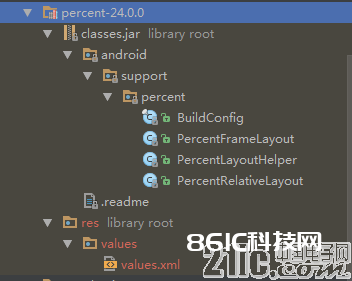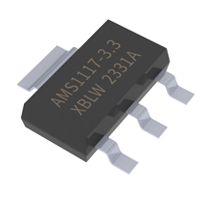1.引进:compile ‘com.android.support:percent:24.0.0’
2.点开源码能够看到,主要有两个布局类PercentFrameLayout和PercentRelativeLayout,一个东西类PercentLayoutHelper。

3.点开布局类比方PercentRelativeLayout的源码,能够看到完成的很简略。
public class PercentRelativeLayout extends RelativeLayout {
private final PercentLayoutHelper mHelper = new PercentLayoutHelper(this);
/**省掉若干行结构办法之类的代码**/
@Override
protected void onMeasure(int widthMeasureSpec, int heightMeasureSpec) {
//要点在这
mHelper.adjustChildren(widthMeasureSpec, heightMeasureSpec);
super.onMeasure(widthMeasureSpec, heightMeasureSpec);
if (mHelper.handleMeasuredStateTooSmall()) {
super.onMeasure(widthMeasureSpec, heightMeasureSpec);
}
}
@Override
protected void onLayout(boolean changed, int left, int top, int right, int bottom) {
super.onLayout(changed, left, top, right, bottom);
mHelper.restoreOriginalParams();
}
public static class LayoutParams extends RelativeLayout.LayoutParams
implements PercentLayoutHelper.PercentLayoutParams {
private PercentLayoutHelper.PercentLayoutInfo mPercentLayoutInfo;
public LayoutParams(Context c, AttributeSet attrs) {
super(c, attrs);
mPercentLayoutInfo = PercentLayoutHelper.getPercentLayoutInfo(c, attrs);
}
/**省掉若干行结构办法之类的代码**/
@Override
public PercentLayoutHelper.PercentLayoutInfo getPercentLayoutInfo() {
if (mPercentLayoutInfo == null) {
mPercentLayoutInfo = new PercentLayoutHelper.PercentLayoutInfo();
}
return mPercentLayoutInfo;
}
@Override
protected void setBaseAttributes(TypedArray a, int widthAttr, int heightAttr) {
PercentLayoutHelper.fetchWidthAndHeight(this, a, widthAttr, heightAttr);
}
}
}
便是在onMeasure和onLayout里边调用了PercentLayoutHelper 的一些办法,别的在里边界说了自己的LayoutParams ,而这个LayoutParams 也适当简略。
这儿要害的一行代码是在onMeasure办法里边,mHelper.adjustChildren(widthMeasureSpec, heightMeasureSpec);经过PercentLayoutHelper 的adjustChildren 遍历子view来设置 子view的宽高,宽高在PercentLayoutHelper 的内部类PercentLayoutInfo经过在布局文件中设置的值核算好了。
public void adjustChildren(int widthMeasureSpec, int heightMeasureSpec) {
// Calculate available space, accounting for host’s paddings
int widthHint = View.MeasureSpec.getSize(widthMeasureSpec) – mHost.getPaddingLeft()
– mHost.getPaddingRight();
int heightHint = View.MeasureSpec.getSize(heightMeasureSpec) – mHost.getPaddingTop()
– mHost.getPaddingBottom();
for (int i = 0, N = mHost.getChildCount(); i N; i++) {
//遍历子view来设置 子view的宽高
View view = mHost.getChildAt(i);
ViewGroup.LayoutParams params = view.getLayoutParams();
if (DEBUG) {
Log.d(TAG, should adjust + view + + params);
}
if (params instanceof PercentLayoutParams) {
PercentLayoutInfo info =
((PercentLayoutParams) params).getPercentLayoutInfo();
if (info != null) {
if (params instanceof ViewGroup.MarginLayoutParams) {
info.fillMarginLayoutParams(view, (ViewGroup.MarginLayoutParams) params,
widthHint, heightHint);
} else {
info.fillLayoutParams(params, widthHint, heightHint);
}
}
}
}
}
4.布局中的运用办法:以PercentRelativeLayout为例
xmlns:app=http://schemas.android.com/apk/res-auto
android:layout_width=match_parent
android:layout_height=match_parent
android:background=@color/background_color
>
android:id=@+id/mian_tab_name
android:layout_width=wrap_content
android:layout_height=wrap_content
android:gravity=center
android:textColor=@color/back_green
android:textSize=15sp
android:text=name
/>
app:layout_widthPercent=50%
app:layout_heightPercent=50%
android:src=@drawable/ic_launcher_icon
android:scaleType=fitXY
android:layout_below=@+id/mian_tab_name
android:background=@color/black
/>
引进xmlns:app的命名空间,然后app:layout_widthPercent=50%就能够设置宽高的百分比了。适当简略 。
5.不过在运用的过程中,或许会有一些其他的需求,比方app:layout_widthPercent=50%,app:layout_heightPercent=50%都是相对于屏幕的宽高的,假设要显现一张正方形的图片,以宽的50%为准呢?这个时分就能够这样写了:
app:layout_widthPercent=50%
app:layout_aspectRatio=100%
android:src=@drawable/ic_launcher_icon
android:scaleType=fitXY
android:layout_below=@+id/mian_tab_name
android:background=@color/CS_black
/>
运用layout_aspectRatio特点,设置app:layout_aspectRatio=100%,layout_aspectRatio便是宽高比。这个时分就不要设置app:layout_heightPercent特点了。在PercentLayoutHelper 里边, 源代码如下:
public void fillLayoutParams(ViewGroup.LayoutParams params, int widthHint,
int heightHint) {
// Preserve the original layout params, so we can restore them after the measure step.
mPreservedParams.width = params.width;
mPreservedParams.height = params.height;
// We assume that width/height set to 0 means that value was unset. This might not
// necessarily be true, as the user might explicitly set it to 0. However, we use this
// information only for the aspect ratio. If the user set the aspect ratio attribute,
// it means they accept or soon discover that it will be disregarded.
final boolean widthNotSet =
(mPreservedParams.mIsWidthComputedFromAspectRatio
|| mPreservedParams.width == 0) (widthPercent 0);
final boolean heightNotSet =
(mPreservedParams.mIsHeightComputedFromAspectRatio
|| mPreservedParams.height == 0) (heightPercent 0);
if (widthPercent >= 0) {
params.width = (int) (widthHint * widthPercent);
}
if (heightPercent >= 0) {
params.height = (int) (heightHint * heightPercent);
}
//这一段代码是要害,假设aspectRatio >=0,aspectRatio是宽高比
if (aspectRatio >= 0) {
if (widthNotSet) {
//假设宽没有设置,就以高为准
params.width = (int) (params.height * aspectRatio);
// Keep track that we’ve filled the width based on the height and aspect ratio.
mPreservedParams.mIsWidthComputedFromAspectRatio = true;
}
if (heightNotSet) {
//假设高没有设置,就以宽为准
params.height = (int) (params.width / aspectRatio);
// Keep track that we’ve filled the height based on the width and aspect ratio.
mPreservedParams.mIsHeightComputedFromAspectRatio = true;
}
}
if (DEBUG) {
Log.d(TAG, after fillLayoutParams: ( + params.width + , + params.height + ));
}
}
6.别的,假设咱们要界说自己的PercentLinearLayout,根本能够直接改一下姓名,承继自LinearLayout就好了:public class PercentLinearLayout extends LinearLayout ,在模仿PercentRelativeLayout里边的LayoutParams界说一个自己的LayoutParams就好了。
不过官方为什么没有直接供给一个PercentLinearLayout 类,而只供给了两个PercentFrameLayout和PercentRelativeLayout呢?









